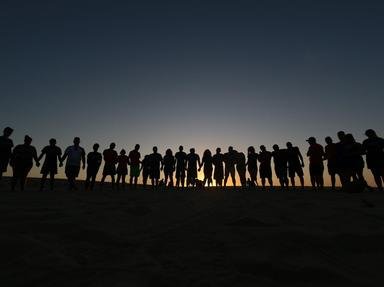Quiz Answer Key and Fun Facts
1. Many of Ronald Colman's early silent films are considered lost, but we can still watch his first American effort, "The White Sister", in which he plays an Italian army officer believed dead by his beloved, who then enters a convent. The big-budget 1923 affair even included the eruption of Mount Vesuvius!
What "Birth of a Nation" star, who often worked with her sister Dorothy, selected Colman as her co-star, after she saw him in a New York play?
2. After coming to America and beginning a silent film career, Ronald Colman was paired with Vilma Bánky, a beautiful actress, for a series of films with titles like "The Night of Love" and "Two Lovers".
Another movie with Bánky, based on a popular play, concerns a love triangle about a soldier (Colman) blinded in World War I. His sweetheart thinks he is dead, so she is about to marry his friend when she learns the man she truly loves is alive, so she goes to find him. It was later remade with Fredric March as the veteran. What is this tearjerker?
3. In the early days of the Academy Awards, actors could be nominated or win for their body of work over a year, rather than for a single performance. Ronald Colman was nominated for Best Actor of 1929 for two films: "Condemned" and for another, which was his first talking picture. What was this other picture?
4. Sixty years before the 1993 Kevin Kline movie "Dave", Ronald Colman appeared in "The Masquerader", a movie with a similar theme about a look-a-like who takes the place of a prominent person. What was the situation in this movie?
5. Ronald Colman made only two films in which he did not wear his trademark moustache. One is the spectacular 1935 "A Tale of Two Cities". The other is a highly fictionalized biography of the man credited with securing an entire subcontinent for the British Crown. What is this other movie?
6. It's incomprehensible that Ronald Colman wasn't nominated for Best Actor for his performance in the 1935 film version of "A Tale of Two Cities". His voice-over of the famous final words "It is a far, far better thing I do now than I have ever done..." is still considered a model of nobility.
What producer, most famous for "Gone with the Wind" and "Rebecca", each of which won the Academy Award for Best Picture, was responsible for "A Tale of Two Cities"?
7. A film adapted from Rudyard Kipling's first novel, "The Light that Failed", became the vehicle for one of Ronald Colman's best performances. The story of a painter who is going blind featured a young actress in her film debut, who played the part of the artist's malicious model. Colman wanted Vivien Leigh for the part, but he was overruled.
The actress who got the role made an big impression, leading to roles opposite Humphrey Bogart in "They Drive by Night" and "High Sierra". She later became a pioneering female director and producer. Who was she?
8. Ronald Colman's final - and only winning - Oscar nomination came for his 1947 film "A Double Life", in which he stars as Anthony John, an unstable stage actor who murders a waitress played by Shelley Winters. In what Broadway play is Anthony John starring when he becomes unhinged?
9. The big-budget 1937 film "Lost Horizon", adapted from a novel by James Hilton, cast Ronald Colman as Robert Conway, a British diplomat whose plane crashes in the Himalayas. The passengers are led to a lovely valley "where people never grow old and peace and goodness prevail".
What is the name of this enchanted valley?
10. It almost goes without saying that Ronald Colman was the most debonair man on any film screen on which he appeared. But in the 1942 picture "The Talk of the Town", a co-star gave him a run for his money in the suave department, and gave their leading lady an impossible choice. Who is this fabulously sophisticated, urbane gentleman?
Source: Author
BarbaraMcI
This quiz was reviewed by FunTrivia editor
skunkee before going online.
Any errors found in FunTrivia content are routinely corrected through our feedback system.

